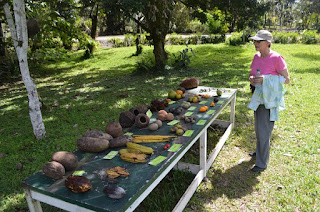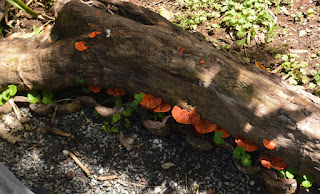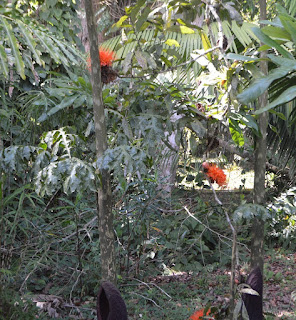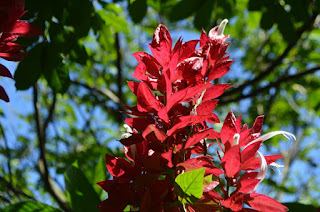We headed down into Turrialba with Sam and Abraham to go to the weekly farmer’s market, hoping as well to pick up some cash, given that we have been having trouble finding ATM’s that will take our bank card. We waited in line for a bank ATM; Sam was able to to get cash, but I was not.
Then down to the market; there were perhaps 100 vendors, with plenty of fruits and vegetables to be had; we got enough for the duration of our stay.
But a fair amount of my time was spent herding Abe around the outside of the market, making sure he did not head into any of the surrounding streets.
Sam and Abe had come in a separate car so that Abe could head home for his lunch and early afternoon nap; Nancy and I, however, headed out of town to visit the Centro Agronómico Tropical de Investigación y Enseñanza (CATIE), a regional “institute for agricultural development and biological conservation in Central America and the Caribbean”. It claims to be the first graduate school in agricultural sciences in Latin America; for us, it was a chance to look at botanical gardens and perhaps learn something about area plants.
Near the entrance, we saw this table laden with fruits from the plants in the garden, some labeled, some not
Generally, the botanical garden had many interesting plants – I was focused on the fruits and flowers — but the labeling was somewhat haphazard, and overall the whole place had something of a run-down feel.
Here are some things we saw for which I could not find any labels:
a plant with an oddly shaped yellow fruit (that is, each fruit had protuberances rather like a mickey mouse ; the leaves were hairy with spines
There were these plants looking somewhat like that maracas in the garden of our house, but skinnier
This log was trimmed with some delicate looking thin red fungus
I would have liked to have learned the name of this fruit or flower that was as hairy as a rambutan, but much smaller
I loved the look of this plant’s thin purple leaves

There were several stands of bamboo. This small one is shown here with a ficus tree, btu some were so large that they towered overhead
The ficus tree was labeled, as the photo shows.
And there was a kapok tree
at its base was this lovely plant with purple leaves and small flowers
This is a “cannonball tree”
This flower was called a devil’s tongue
And this the “rose of Venezuela
This large flower, the draconium pitteri, gives off a stench resembling carrion, drawing insects to be devoured (note the rose of Venezuela in the rear)
Then Angel’s trumpet
the Matrimonio
and the penta (also called canastilla), coming in several different colors
On the pavoncillo rojo, note the delicate white flowers within each cluster
rabo de zorro
Here the monstera deliciosa, often seen in the US as a houseplant, is shown with its fruit
We walked past and through stands of torch ginger;
there were so many flowers in different stages of their development that we were able to get a good sense of the cycle
Here is a side and top view of the flower in its early stage
From the top view, we can see the central portion that is starting to emerge here
Here, the central part is entirely out and starting to drop its petals
which, here, are almost all gone
Here is a pink version
After visiting spending ninety minutes walking around CATIE, we headed home past the Maxi Pali supermarket where the ATM readily replenished my supply of cash.





























































